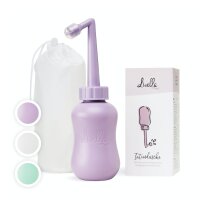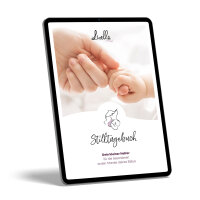There is no breastfeeding without milk let down. The let-down reflex ensures that the breast milk is released from the mammary glands and flows towards the nipples. If it doesn’t happen, the baby will suckle at the breast in vain, only managing to extract a few scattered drops of milk that might be left in the ducts from the last feeding.
But what exactly happens in the female body during let down? How can breastfeeding mums stimulate their let-down reflex? And what helps when the milk let down is too strong or too weak?
Table of contents
Let-down reflex feeling: what does let down feel like?
What causes the let-down reflex? And what hinders it?
What is milk let down?
Milk let down (short: let down) is when the alveoli (i. e. the milk-producing glands in the breast) contract to release the breast milk into the milk ducts which transport it to the nipples where it is ejected into the baby’s mouth. In a nutshell, let down is what makes your breast milk flow during breastfeeding.
The let-down reflex is the physiological basis of breastfeeding. It is triggered by the release of the hormone oxytocin, which is why the reflex is also called oxytocin reflex or milk ejection reflex. Oxytocin is released every time the baby suckles at the breast.
Good to know: The let-down reflex is always triggered in both breasts, meaning that the breast milk stored in the alveoli is transported to both nipples. Breast milk that isn’t consumed during a feed usually travels back into the alveoli once the baby stops suckling.

Let-down reflex feeling: what does let down feel like?
Let down feels different for every woman. Some mothers describe the onset of the reflex as a spreading feeling of warmth or a pleasant tingling sensation. For others, however, the feeling resembles an uncomfortable contracting or pulling sensation.
In some cases, there may even be slight to sharp let-down pain when breastfeeding, and yet others don’t notice the reflex kicking in at all. Since oxytocin also causes the uterus to contract, it’s also possible for a woman to experience uterine pain as the milk starts to flow.
If you don’t feel anything at all during let down, you can tell if the reflex is working correctly by looking at your baby. Once your milk starts to flow, your baby will start swallowing deeply and rhythmically.
What causes the let-down reflex? And what hinders it?
In order to know how to trigger the let-down reflex, women first need to understand what factors cause and hinder the onset of the reflex. The first thing you should keep in mind is that the milk ejection reflex is closely linked to your sensations and feelings.
What this means is that your emotional and psychological state can influence whether the reflex works properly or not. Feelings like insecurity, fear, stress, lack of self-confidence, or shock can temporarily prevent the body from releasing oxytocin and thus inhibit the let-down reflex.
Other factors that may be to blame when your let-down reflex is not working properly include:
- Your breastfeeding diet and the consumption of alcohol, nicotine, and caffeine,
- Tension in your body,
- Lack of sleep,
- Lack of stimulation due to bad breastfeeding latch and attachment, and
- Discomfort and pain.

How to stimulate the let-down reflex?
The main trigger of the let-down reflex is when your baby suckles at your breast. Since there are many factors that can inhibit let down, it’s not rare for new mums to experience problems when it comes to their milk flow, especially in the first few days and weeks after birth.
Here are some tips that can help you trigger your milk ejection reflex and make your milk flow more easily:
- Relaxation: Stress and tension are two of the main inhibitors of the let-down reflex. One of the measures you can use to make your milk flow more easily hence consists in unwinding and relaxing. Finding a comfortable position for breastfeeding, eliminating everything that might be a distraction, or listening to soothing music can help here.
- Breathing exercises: Breathing exercises are a wonderful way of getting into the state of calm and relaxation that is needed for successful breastfeeding.
- Hot drinks: Some mothers find it helpful to have a hot drink while breastfeeding. Drinking herbal infusions or breastfeeding tea is preferable to consuming coffee.
- Enough sleep: Getting enough sleep is vital for successful breastfeeding. For one thing, your body needs to be well-rested to have enough energy for milk production and breastfeeding. For another thing, a lack of sleep can adversely affect your milk let down.
- Skin-to-skin contact: Skin-to-skin contact between mother and baby is crucial for triggering the release of oxytocin in the mother’s body. It also triggers feelings of affection in both mother and baby.
- Breastfeeding position and latch: Finding a comfortable breastfeeding position and getting a good latch are essential for promoting milk flow. Your baby needs to be latched on correctly in order to suck effectively and trigger your milk ejection reflex.
- Hot therapy: Applying a warm compress or a heated breast gel pad to the breast can help stimulate milk flow because warmth widens the milk ducts, making it easier for the milk to flow through.
Common let-down problems
There are two common issues with let-down: forceful let down (also known as overactive let down) and weak let down. Let’s look at each of them individually.
Weak let-down reflex
Especially in the early days of breastfeeding, it’s not uncommon for a woman’s breast milk to not flow as easily as she would like it to. Potential causes for a weak or slow milk let down include:
- Alcohol consumption,
- Stress and tension,
- Negative emotions (e. g. fear or insecurity),
- Smoking,
- Heavy blood loss,
- Exhaustion,
- Low breastfeeding frequency,
- Breastfeeding pain, such as sore nipples or breast engorgement,
- Use of medication,
- High intake of caffeine,
- Weak suckling reflex in the baby,
- and Cold.
The problem with weak let down is that it can lead to other breastfeeding problems over time. For instance, your baby will have to suck longer and harder on the breast to quench its thirst, which can lead to sore nipples in the long run. Also, if the breast is not emptied properly, the risk of breast problems like blocked milk ducts or mastitis increases.
To avoid further complications, you should take action as soon as possible if you notice that you have a weak let down. In addition to the different tips and techniques on how to stimulate milk let down, you can try to:
- Massage your breast before breastfeeding,
- Use oxytocin nasal spray,
- Become more self-confident in your abilities to breastfeed your baby, or
- Switch breasts frequently to continuously trigger a new let down.
Many breastfeeding mums wonder: Does slow let down mean low milk supply? No, just because your milk flows slowly, this doesn’t mean that your milk supply is low. Breast milk volume and let down are not related.
Overactive let-down reflex
Some women experience the opposite problem. Instead of flowing too slowly, their breast milk shoots out uncontrollably, causing the baby to cough, splutter, choke and spit up. The strong milk flow makes it hard for an infant to stay attached to the maternal breast and can lead to frustration in the long term.
An overactive let-down reflex (also called forceful let down) often goes hand in hand with an oversupply of breast milk. Women with a forceful milk let down can hence adopt the same techniques that also help manage breast milk oversupply. This includes:
- Expressing breast milk by hand before each feeding,
- Choosing a breastfeeding position in which gravity slows the milk flow down, such as
- laid-back nursing,
- Allowing for short breaks that give the baby time to breathe,
- Applying a cold compress or cooling pad to the breast before each feed,
- Compressing the breast during feeding to slightly block the milk ducts,
- Using nipple shields to slow down the milk flow, and
- Increasing breastfeeding frequency.
If you still struggle to manage your strong milk flow, you should seek help and get some professional support from a midwife or lactation consultant. They can offer advice and give you some additional tips.
Let-down reflex: the most important facts at a glance
- The let-down reflex represents the physiological basis of breastfeeding.
- Oxytocin is the let-down reflex hormone. Its release causes the milk-producing cells to contract which releases the breast milk into the milk ducts.
- Milk let down feels different for every woman, ranging from a tingling sensation to shooting pain.
- If you notice your let down is suddenly taking longer, this could be due to different reasons, including lack of sleep, stress, bad nutrition, or high consumption of caffeine.
- There are different ways for breastfeeding women to stimulate their let-down reflex, including breast massages, skin-to-skin contact and applying warmth to the breast.
- In case of a forceful let down, breastfeeding in a position that reduces the force of gravity and compressing the breast can help slow the milk flow down.
References
- The physiological basis of breastfeeding - Infant and Young Child Feeding - NCBI Bookshelf (nih.gov)
- Breastfeeding: the first few days - NHS (www.nhs.uk)
- Oversupply - La Leche League GB
- Oversupply and Forceful Letdown (Milk Ejection Reflex) | La Leche League Canada - Breastfeeding Support and Information (lllc.ca)
- Common breastfeeding challenges | Office on Women's Health (womenshealth.gov)
- Milchspendereflex: Wie funktioniert das eigentlich mit dem Milchfluss (livella.de)

















